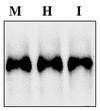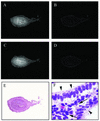Transcriptional repression of peri-implantation EMX2 expression in mammalian reproduction by HOXA10
- PMID: 12482956
- PMCID: PMC140663
- DOI: 10.1128/MCB.23.1.1-13.2003
Transcriptional repression of peri-implantation EMX2 expression in mammalian reproduction by HOXA10
Abstract
HOXA10 is necessary for mammalian reproduction; however, its transcriptional targets are not completely defined. EMX2, a divergent homeobox gene, is necessary for urogenital tract development. In these studies we identify and characterize the regulation of EMX2 by HOXA10. By using Northern analysis and in situ hybridization, we found that EMX2 is expressed in the adult urogenital tract in an inverse temporal pattern from HOXA10, suggestive of a negative regulatory relationship. Constitutive expression of HOXA10 diminished EMX2 mRNA, whereas blocking HOXA10 through the use of antisense resulted in high EMX2 mRNA expression. Deletional analysis of the EMX2 5' regulatory region revealed that a 150-bp element mediated transcriptional repression when cotransfected with pcDNA3.1/HOXA10 in transient-transfection assays. Binding of HOXA10 protein to this element was demonstrated by electrophoretic mobility shift assay and further localized to a consensus HOXA10 binding site within this element by DNase I footprinting. Site-directed mutagenesis abolished binding, as well as the negative transcriptional regulation. Transcriptional activation of empty spiracles, the Drosophila ortholog of EMX2, by Abdominal-B (HOXA10 ortholog) has been previously demonstrated. These findings demonstrate conservation of the transcription factor-target gene relationship, although the direction of regulation is reversed with possible evolutionary implications.
Figures









Similar articles
-
A novel role for the AAA ATPase spastin as a HOXA10 transcriptional corepressor in Ishikawa endometrial cells.Mol Endocrinol. 2011 Sep;25(9):1539-49. doi: 10.1210/me.2011-0001. Epub 2011 Jul 14. Mol Endocrinol. 2011. PMID: 21757506 Free PMC article.
-
EMX2 gene expression in the female reproductive tract and aberrant expression in the endometrium of patients with endometriosis.J Clin Endocrinol Metab. 2004 May;89(5):2390-6. doi: 10.1210/jc.2003-031389. J Clin Endocrinol Metab. 2004. PMID: 15126568
-
Emx2 regulates mammalian reproduction by altering endometrial cell proliferation.Mol Endocrinol. 2005 Nov;19(11):2839-46. doi: 10.1210/me.2005-0130. Epub 2005 Jun 30. Mol Endocrinol. 2005. PMID: 15994197
-
The role of the Hoxa10/HOXA10 gene in the etiology of endometriosis and its related infertility: a review.J Assist Reprod Genet. 2010 Dec;27(12):701-10. doi: 10.1007/s10815-010-9471-y. Epub 2010 Sep 7. J Assist Reprod Genet. 2010. PMID: 20821045 Free PMC article. Review.
-
HOXA10 signals on the highway through pregnancy.J Reprod Immunol. 2009 Dec;83(1-2):72-8. doi: 10.1016/j.jri.2009.07.009. Epub 2009 Oct 24. J Reprod Immunol. 2009. PMID: 19854516 Review.
Cited by
-
HOXA10 regulates endometrial GABAA {pi} receptor expression and membrane translocation.Am J Physiol Endocrinol Metab. 2010 Apr;298(4):E889-93. doi: 10.1152/ajpendo.00577.2009. Epub 2010 Jan 26. Am J Physiol Endocrinol Metab. 2010. PMID: 20103740 Free PMC article.
-
Tissue selective estrogen complexes (TSECs) differentially modulate markers of proliferation and differentiation in endometrial cells.Reprod Sci. 2013 Feb;20(2):129-37. doi: 10.1177/1933719112463251. Epub 2012 Nov 20. Reprod Sci. 2013. PMID: 23171676 Free PMC article.
-
Myeloid ecotropic viral integration site 1 (MEIS) 1 involvement in embryonic implantation.Hum Reprod. 2008 Jun;23(6):1394-406. doi: 10.1093/humrep/den082. Epub 2008 Apr 11. Hum Reprod. 2008. PMID: 18408019 Free PMC article.
-
Thrombin and interleukin-1beta decrease HOX gene expression in human first trimester decidual cells: implications for pregnancy loss.Mol Hum Reprod. 2009 Jul;15(7):451-7. doi: 10.1093/molehr/gap030. Epub 2009 Apr 22. Mol Hum Reprod. 2009. PMID: 19389728 Free PMC article.
-
HOXA10 Expressing UCMSCs Transplantation Improved Endometrial Receptivity on Endometrial Injury.Curr Stem Cell Res Ther. 2023;18(7):1001-1012. doi: 10.2174/1574888X17666220919111814. Curr Stem Cell Res Ther. 2023. PMID: 36121094 Free PMC article.
References
-
- Akam, M. 1989. Hox and HOM: homologous gene clusters in insects and vertebrates. Cell 57:347-349. - PubMed
-
- Awgulewitsch, A., and D. Jacobs. 1992. Deformed autoregulatory element from Drosophila functions in a conserved manner in transgenic mice. Nature 358:341-344. - PubMed
-
- Bagot, C. N., H. J. Kliman, and H. S. Taylor. 2001. Maternal Hoxa10 is required for pinopod formation in the development of mouse uterine receptivity to embryo implantation. Dev. Dyn. 222:538-544. - PubMed
-
- Bagot, C. N., P. J. Troy, and H. S. Taylor. 2000. Alteration of maternal Hoxa10 expression by in vivo gene transfection affects implantation. Gene Ther. 7:1378-1384. - PubMed
Publication types
MeSH terms
Substances
Grants and funding
LinkOut - more resources
Full Text Sources
Molecular Biology Databases
Research Materials
